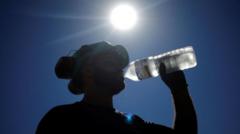The World Health Organization (WHO) has raised alarms about the growing risks of heat stress in the workplace, spotlighting the urgent need for protective measures as climate change leads to more frequent and intense heatwaves. A newly released report highlights that millions of workers worldwide, especially in construction and agriculture, are increasingly vulnerable to heat-related health issues, which not only affect well-being but also impact productivity.
This report marks the first time since 1969 that the WHO has focused specifically on heat stress at work, signaling the severity of the situation. Rüdiger Krech, WHO’s director of environment, climate and health, describes the findings as a necessary wake-up call; rising body temperatures significantly increase the risk of complications like heat stroke and dehydration.
As climate data shows unprecedented temperature records, workplaces must adapt to these changing conditions. Heatwaves can now frequently push temperatures beyond 40°C (104°F) in Europe, while parts of Africa and the Middle East have seen extreme highs exceeding 50°C. Such conditions come with severe implications; the report reveals that for every one degree Celcius rise above 20°C, there is a 2% decline in productivity. Furthermore, workplace accidents see a notable increase as heat affects concentration levels. Reports from Switzerland during the summer of 2023 showed a 7% spike in work-related accidents when temperatures surpassed 30°C.
In response, several European nations are implementing measures to safeguard workers during extreme heat. Italy, for example, recently enacted emergency legislation ensuring workers can avoid the most oppressive midday heat. In Switzerland, work was suspended during the heatwaves, leading to calls for construction companies to be proactive in recognizing unsafe working conditions due to heat.
The report doesn't solely highlight workplace concerns but also addresses the risks posed to vulnerable populations such as the elderly, chronically ill, and children. Educational facilities are encouraged to adapt, echoing sentiments from the education sector in Germany where institutions can declare "Hitzefrei" on excessively hot days— an approach that has become less common as extreme temperatures have risen.
In Switzerland, as schools resumed last week with heat levels over 30°C, teachers faced challenges in maintaining effective learning environments. Calls for better infrastructure in schools, including improved ventilation and air conditioning, have grown louder. Krech encourages a collaborative approach involving various stakeholders to develop effective adaptations.
However, the WHO report points out that while necessary, funding for these adaptations is often sidelined for other priorities such as defense spending. Krech warns that neglecting climate-related initiatives could yield costly consequences in both health and productivity. As governments grapple with priorities, it is essential to recognize the long-term financial impacts of failing to invest in adaptable workplace and educational environments.
Amidst these challenges, the WHO strongly advocates for preemptive and cooperative efforts to ensure that both workers and students can adapt to the new reality of our warming world.
This report marks the first time since 1969 that the WHO has focused specifically on heat stress at work, signaling the severity of the situation. Rüdiger Krech, WHO’s director of environment, climate and health, describes the findings as a necessary wake-up call; rising body temperatures significantly increase the risk of complications like heat stroke and dehydration.
As climate data shows unprecedented temperature records, workplaces must adapt to these changing conditions. Heatwaves can now frequently push temperatures beyond 40°C (104°F) in Europe, while parts of Africa and the Middle East have seen extreme highs exceeding 50°C. Such conditions come with severe implications; the report reveals that for every one degree Celcius rise above 20°C, there is a 2% decline in productivity. Furthermore, workplace accidents see a notable increase as heat affects concentration levels. Reports from Switzerland during the summer of 2023 showed a 7% spike in work-related accidents when temperatures surpassed 30°C.
In response, several European nations are implementing measures to safeguard workers during extreme heat. Italy, for example, recently enacted emergency legislation ensuring workers can avoid the most oppressive midday heat. In Switzerland, work was suspended during the heatwaves, leading to calls for construction companies to be proactive in recognizing unsafe working conditions due to heat.
The report doesn't solely highlight workplace concerns but also addresses the risks posed to vulnerable populations such as the elderly, chronically ill, and children. Educational facilities are encouraged to adapt, echoing sentiments from the education sector in Germany where institutions can declare "Hitzefrei" on excessively hot days— an approach that has become less common as extreme temperatures have risen.
In Switzerland, as schools resumed last week with heat levels over 30°C, teachers faced challenges in maintaining effective learning environments. Calls for better infrastructure in schools, including improved ventilation and air conditioning, have grown louder. Krech encourages a collaborative approach involving various stakeholders to develop effective adaptations.
However, the WHO report points out that while necessary, funding for these adaptations is often sidelined for other priorities such as defense spending. Krech warns that neglecting climate-related initiatives could yield costly consequences in both health and productivity. As governments grapple with priorities, it is essential to recognize the long-term financial impacts of failing to invest in adaptable workplace and educational environments.
Amidst these challenges, the WHO strongly advocates for preemptive and cooperative efforts to ensure that both workers and students can adapt to the new reality of our warming world.





















